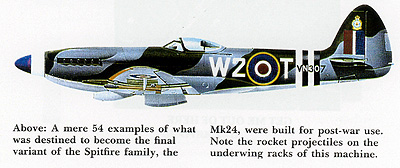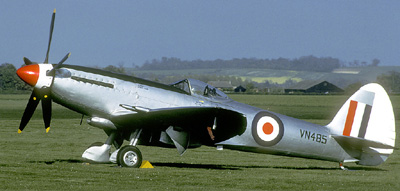SGT. KEN COOP

Ken Coop wrote this article for our Newsletter
some years ago; these are a few of his memories of his post-war
career with the RAF, flying such formidable aircraft as the
Spitfire Mk.24 and the mighty Tempest V.
Interestingly, our Chairman David Williams tells
me that both he and Ken attended the same training units; No.25
EFTS (Belvedere) and 20 SFTS (Cranborne) with the Rhodesian Air
Training Group in Salisbury, and that after leaving the RAF,
with flying still very much in his blood, Ken flew civilian
aircraft with East African Airways under their Senior Captain,
one of the most respected civil pilots of the day, the late
(John) Peter Cunningham, himself a former Spitfire pilot with 43
Squadron, and also a great friend to this region of the Spitfire
Society.
Ken Coop was a wonderful gentleman, with
a ready smile and an easy-going nature that put one at ease in
his company. Kind and generous, he had long been a keen
supporter of the Eastern Wing, until recently to be found most
summers at air shows helping raise funds by working on our sales
stand and attending regional events and activities.
We understand that things may not have been as
well for Ken lately as one might wish them to be, and it is with
that thought in mind we dedicate this first online presentation
of the article below to Ken, with our very best wishes.
P.W.
After being
released from the RAF, I was invited to sign on for a further
three years engagements and had previously served with 253
Squadron in Italy and Austria, on the Spitfire Mk VIII and IX.
I was posted
to the Photo Reconnaissance Operational Conversion Unit at
Benson for a P.R. course on the Spitfire XIX. These were
'Griffin' powered with no armament, but much increased fuel for
greater range. After completing training, two of us were sent to
2nd TAP in Germany; we thought, to join the P.R. Squadron at
Wunstorf. However the Wing Commander there said we would not be
required on P.R. work. There were several Tempest Squadrons
there, so we decided to toss a coin to choose which one to join!
I got 80 Squadron flying Tempest V’s. This was a much heavier
aircraft than the Spitfire, with a more powerful engine (the
Napier Sabre). This carried 4x20mm cannons and 6 Rocket
Projectiles for air to ground attacks. I didn't fly a lot in
them as serviceability was rather poor (probably a shortage of
spares).

In January
1948 we started to re-equip with the Spitfire XXIV. I was with
the first four to change over to this Mark, with the C.O.
Squadron Leader Newberry leading. We first flew the Tempests to
Mansion in Kent and had a pleasant few days there before
delivering them to Brize-Norton. From there we were driven to
Lyneham to pick up the Spitfires, as we had been given the
pilots notes before leaving. The Spitfire XXIVs were much
lighter to handle than the Tempest, but had similar armament,
with an extra fuel tank behind the cockpit, but these could only
be used for ferrying.
This time we
routed back via Mansion and then Eindhoven in Holland, but had
to return to Mansion due to bad weather. When we finally got
back to Wunstorf, the round trip had taken two weeks. I
subsequently ferried two more back, but this only took a few
days each.
The Squadron
soon settled in with the new aircraft, with plenty of training!
In April 1948 we went to Lubeck for the Armament practice camp
using Cannon, RPs, together with bombing. Some air to air was
done with our Harvard towing a drone. About this time the C.O. (Sqn
Ldr Newberry) was killed while leading a battle formation. He
was struck from below by another aircraft and although he bailed
out, he unfortunately died by hitting trees on landing. This was
a real blow to the Squadron, as the 'Boss' was well liked and
respected by everyone. The C.O. was replaced by Squadron Leader
Tremlett and shortly after, some of us flew to Thorney Island,
for a few days. This was for a demonstration over Netheravon.
In June 1948
we were sent to Berlin, flying a mile apart down the corridor.
This was due to the tension with Russia over the access by road
from West Germany. We were there for nearly three weeks and did
not fly until we finally left. This time to Gütersloh, as
Wunstorf had been taken over for the Berlin Airlift. There was
already several Squadrons of fighters there. After a few days we
went to Lubeck for some armament training.
The Tempest
Squadrons were converting to the D.H. Vampire jet fighter and we
would have been the last ones to convert. Then out of the blue
came the news that the Squadron was being sent to Hong Kong with
33 Squadron to Singapore for Malaysia
In July we
flew to Renfrew for embarkation on the Aircraft Carrier 'Ocean',
first calling at Singapore to disembark 33 Squadron. I did not
like the trip on the 'Ocean' as it was pretty boring. The only
bright spot was at lunch, when we had our 'rum rations'. But
unfortunately nothing of the same in the evening. We did however
have the occasional film and tombola. At Singapore we had a few
days to sample the local brew (Tiger). As we approached Hong
Kong we were met by Spitfire XVIIIs (28 Squadron). They were
equipped with cameras for Tactical Reconnaissance work. We lost
no time in Hong Kong whilst they unloaded the Spitfires and
stores, to walk to the Sergeants Mess and try the local brew.
We did a lot
of flying from Kai Tak airfield. This could be tricky,
especially in bad weather, with no direct approach to the
runway. In December three of us went to Singapore to collect
three more Spitfires. We flew down by Transport Command Dakota.
We did a local airtest at Seletar and then onto Butterworth
(Malaya), where we night-stopped, meeting up with some of the
Tempest crews we knew. They were operating against the rebels
and doing a good job.
The next day
we flew across to Saigon in Indo China (as it was then), from
there to Tourain, where we stayed the night. The leg to Hong
Kong was the most critical and we were led by a D.H. Mosquito.
This was Christmas Eve and we were anxious to get back in time
for the next day. We arrived in good shape and were met by the
ground crew with a nice mug of their own brew while we were
still in the cockpit. Boy it really went down well.
At the
beginning of March 1950 we started flying from Sek-Kong, not far
from the Chinese border. It had just been an earth runway.
The idea was
the pierced steel plank runway would be laid, but had yet to
arrive. Rolls of bitumen were laid, but this became un-stuck on
take offs with the Spitfires. We were the first to use it, but
afterwards rotated with 28 Squadron, with about two weeks at
each base. As a matter of interest I believe Group Captain Green
(Spitfire Society Founder) was with this squadron at this time.
Conditions were a bit primitive, living under canvas but we were
allowed to use the Army Sergeants Mess, which was not far away.
The war in
Korea had started that year and we hoped we would be sent, but
it was not to be. As with the Army co-operation, we also did
exercises with the Navy, when they were working up before going
to Korea. I volunteered to go on training exercise with HMS
Triumph, from Hong Kong for three days. In the event I found
myself in the back seat of a Firefly, from Kai Tak, to join the
carrier at sea. This was an interesting experience.
I was
interested in watching the Seafire 47, which in similar to the
Spitfire XXIV, but with contra rotating propellers. This enabled
it to use full power on take off, unlike the Spitfire.
I left Hong
Kong in October 1950 and I believe that 80 Squadron re-equipped
with D.H. Hornets in 1952. The Hong Kong Auxiliary Air Force
took on six Mk XXIV Spitfires. They converted from Austers and a
Harvard at Sek-Kong. This seemed to be expecting a lot from the
pilots who were part time. One of the Spitfires (VN485) is in
the Imperial War Museum Duxford.

Original photograph by Joop
de Groot
I spent the
last year in the RAF flying the Mk XVI Spitfire at home, on
co-operative duty. I thought this Mark much easier to handle but
they were not armed.
I understand
that all MK XXIVs went to 80 Squadron.
K.C.
--------------------------------------------------------------
Previous Spitfire Society interviews can be found in the
Archives section:



